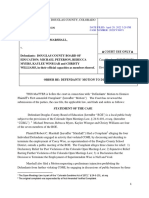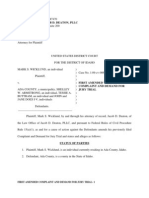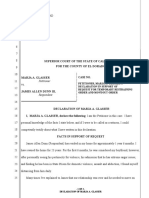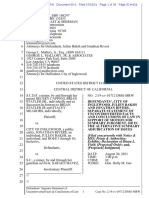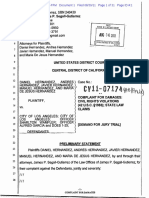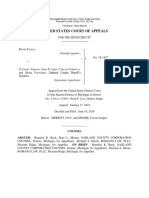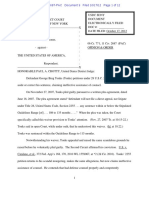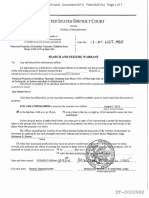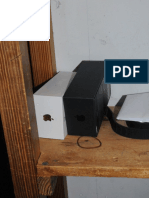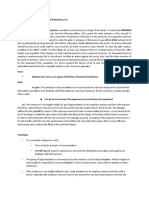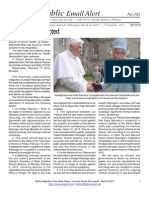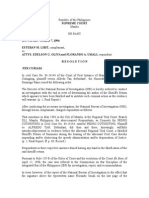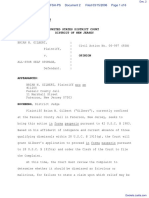1-28-2015 Government's Opposition To Defendant's Third Motion For Change of Venue
1-28-2015 Government's Opposition To Defendant's Third Motion For Change of Venue
Uploaded by
Trial DocsCopyright:
Available Formats
1-28-2015 Government's Opposition To Defendant's Third Motion For Change of Venue
1-28-2015 Government's Opposition To Defendant's Third Motion For Change of Venue
Uploaded by
Trial DocsOriginal Description:
Original Title
Copyright
Available Formats
Share this document
Did you find this document useful?
Is this content inappropriate?
Copyright:
Available Formats
1-28-2015 Government's Opposition To Defendant's Third Motion For Change of Venue
1-28-2015 Government's Opposition To Defendant's Third Motion For Change of Venue
Uploaded by
Trial DocsCopyright:
Available Formats
Case 1:13-cr-10200-GAO Document 992 Filed 01/28/15 Page 1 of 10
UNITED STATES DISTRICT COURT
DISTRICT OF MASSACHUSETTS
UNITED STATES OF AMERICA
v.
DZHOKHAR A. TSARNAEV,
Defendant
)
)
)
)
)
)
Crim. No.13-10200-GAO
GOVERNMENT=S OPPOSITION TO
DEFENDANT=S THIRD MOTION FOR CHANGE OF VENUE
The only new information in Tsarnaevs third motion to change venue is a partial analysis
of completed juror questionnaires, but that analysis does not bolster his arguments for a change of
venue. On the contrary, it confirms that in a nationally-publicized case like this one, fair and
impartial jurors are as likely to be found in the Eastern Division of Massachusetts as anywhere
else, and that a thorough and searching voir dire is the appropriate way to identify them.1
Tsarnaev alleges that [of] the 1,373 jurors filling out questionnaires, all but four said they
had been exposed to publicity about the case; but the same would undoubtedly be true of jurors in
other federal districts as well. Tsarnaevs own telephone survey, commissioned in May 2014,
revealed that nearly 100% of respondents in Springfield, New York City, and Washington, D.C.
said they had been exposed to publicity about this case. (Dkt. 461-23, at 4). That is hardly
surprising. The Marathon bombings were the largest mass-casualty terrorist attack on American
soil since September 11, 2001. The attacks killed three, injured hundreds more, and interrupted
an internationally famous sporting event. The bombings and their bloody aftermath were
Although the government does not object to Tsarnaevs renewing his motion for a change of
venue to the extent it is based on new information, the government does object to his renewed
efforts to supplement the record with the declaration of Neil Vidmar and portions of the Smith
declaration previously stricken by the Court. Those materials are not new information but rather
belated attempts to bolster previous motions.
Case 1:13-cr-10200-GAO Document 992 Filed 01/28/15 Page 2 of 10
televised live and then rebroadcast innumerable times to the Nation and the world. They were
also captured in videos and photographs that have been posted on the internet and collectively
viewed millions of times by a worldwide audience.
Although Boston media outlets notably the Boston Globe and Herald have undoubtedly
published more articles about the attacks than other papers, the Globes entire circulation of
approximately 225,000 amounts to less than 5% of the Eastern Districts population of five
million, and the Heralds amounts to only 2%, making it likely that only a small fraction of the
local population has been exposed to those articles. The completed juror questionnaires bear that
out. Given the nationwide interest in the bombings, a particular jurors news-consumption habits
are likely to have a far greater impact on his or her exposure to pretrial publicity than the district in
which he or she lives. In short, the nationwide notoriety of this case substantially diminishes the
importance of its local notoriety as a factor in the venue calculus.
The same is true of potential jurors opinions about Tsarnaevs guilt. According to
Tsarnaevs motion, the completed jury questionnaires show that [f]ully 68 percent of prospective
jurors already believe that Mr. Tsarnaev is guilty. But according to Tsarnaevs May 2014
survey, the percentages in other districts who believe Tsarnaev is guilty are even greater: 84% in
Springfield, 92% in New York City, and 86% in Washington, D.C. (Dkt. 461-23, at 5). Once
again, the widespread belief in Tsarnaevs guilt is hardly surprising. As the Supreme Court first
observed in 1879 and has repeated many times since, every case of public interest is almost, as a
matter of necessity, brought to the attention of all the intelligent people in the vicinity, and scarcely
any one can be found among those best fitted for jurors who has not read or heard of it, and who
has not some impression or some opinion in respect to its merits. Reynolds v. United States, 98
U.S. 145, 155156 (1879). Accord Irvin v. Dowd, 366 U.S. 717 (1961): Skilling v. United States,
2
Case 1:13-cr-10200-GAO Document 992 Filed 01/28/15 Page 3 of 10
561 U.S. 358, 381 (2010). It is safe to assume that everyone in the country has heard something
about this case, and that potential jurors in other districts, no less than those who live here, have
some impression or some opinion in respect to its merits.
But that doesnt mean jurors cannot set aside their beliefs and apply the presumption of
innocence. On the contrary, it is a premise of [our] system that jurors will set aside their
preconceptions when they enter the courtroom and decide cases based on the evidence presented.
Skilling, 561 U.S. at 398 n.34. Accord Irvin, 366 U.S. at 723 (To hold that the mere existence of
any preconceived notion as to the guilt or innocence of an accused, without more, is sufficient to
rebut the presumption of a prospective juror's impartiality would be to establish an impossible
standard. It is sufficient if the juror can lay aside his impression or opinion and render a verdict
based on the evidence presented in court.); Wells v. Murray, 831 F.2d 468, 472 (4th Cir. 1987)
([Jurors] are presumed to be impartial . . . [and the] existence of a juror's preconceived notion as
to the guilt of the accused will not by itself destroy the presumption of impartiality.). It is
certainly possible that some prospective jurors in this case are already so convinced of Tsarnaevs
guilt that they cannot be impartial; but according to Tsarnaevs own analysis, of the 68% of
potential jurors in this case who have formed an opinion that Tsarnaev is guilty, fully 60% said
they could set aside that opinion and decide the case solely on the evidence, meaning that
three-quarters of the nearly 1,400 jurors who completed questionnaires have an open mind about
the case.
The time-tested method for determining whether a juror can actually set aside his beliefs
and apply the presumption of innocence is voir dire. See Patton v. Yount, 467 U.S. 1025, 1038
n.13 (1984) ([V]oir dire has long been recognized as an effective method of rooting out . . .
[publicity-based] bias, especially when conducted in a careful and thoroughgoing manner.)
3
Case 1:13-cr-10200-GAO Document 992 Filed 01/28/15 Page 4 of 10
(internal quotation marks and citation omitted); Correia v. Fitzgerald, 354 F.3d 47, 52 (1st Cir.
2003) (The best way to ensure that jurors do not harbor biases for or against the parties is for the
trial court to conduct a thorough voir dire examination. Assuming that venirepersons pass
through this screen, the trial court thereafter may operate on the presumption that the chosen jurors
will obey the judge's instructions to put extraneous matters aside and decide each case on its
merits.) (citations omitted).
The Court in this case has undertaken a thorough and probing voir dire of each potential
juror and will no doubt continue to do so until a sufficient number are qualified. It has asked each
juror follow-up questions about all pertinent answers in the jurors questionnaire and then has
allowed the parties to ask their own follow-up questions. The Court has focused its queries on
jurors exposure to pretrial publicity (if any), personal connection to the events (if any), and
preconceived views about Tsarnaevs guilt (if any), among other things. It has not hesitated to
disqualify jurors who appear unable to be fair and impartial, even if they insist that they could be.
When the Court has determined that a potential juror can be fair and impartial, it has made a
credibility judgment based on the jurors words, tone of voice, demeanor, and body language,
among other things. Those types of credibility judgments are entitled to special deference and
may be reversed only for manifest error. Yount, 467 U.S. at 1031-31, 1038.
Despite innumerable judicial decisions endorsing the effectiveness of voir dire, Tsarnaev
claims it will be ineffective because even the most thorough voir dire imaginable could not
[root] out the overwhelming prejudice against him in this district. (Deft. Mot. at 2). As usual,
Tsarnaev attempts to bolster this claim with flights of rhetorical excess: he claims that an
unrelenting tidal wave of media coverage has resulted in extraordinary, striking,
powerful, and staggering levels of local prejudice unprecedented in modern venue
4
Case 1:13-cr-10200-GAO Document 992 Filed 01/28/15 Page 5 of 10
litigation, such that a stronger case for presumed prejudice is difficult to imagine. (Deft. Mot.,
passim.). Local prejudice is so strong, in his view, that [if] this case does not warrant a change of
venue, the entire body of law on venue as it relates to the Constitutional rights to due process and a
fair trial will be left a hollow shell. (Deft. Mot. at 2). But hyperbole is no substitute for a
careful analysis of the facts and law. Tsarnaev cites only one case Irvin v. Dowd -- in which a
court held that adverse pretrial publicity created such a presumption of prejudice that jurors'
claims that they could be impartial had to be disregarded. He contends that the facts of this case
present a far stronger case for a change of venue than the facts of Irvin. But a careful examination
of that case reveals that the opposite is true.2
The defendant in Irvin was convicted of committing one of a string of six murders and
sentenced to death. See Irvin, 366 U.S. at 719. The trial took place in Gibson, Indiana, a rural
county of approximately 30,000 inhabitants. Id.. Four of the murders occurred in March 1955,
and the defendant was arrested on April 8, 1955. Id. Shortly after his arrest, the prosecution and
police issued press releases, which were intensively publicized, stating that the petitioner had
confessed to the six murders. Id. at 719-20. In addition,
a barrage of newspaper headlines, articles, cartoons and pictures was unleashed
against him during the six or seven months preceding his trial. . . . [T]he
newspapers in which the stories appeared were delivered regularly to
approximately 95% of the dwellings in Gibson County. . . . [In] addition, the
Evansville radio and TV stations, which likewise blanketed that county, also
carried extensive newscasts covering the same incidents. These stories revealed
the details of his background, including a reference to crimes committed when a
juvenile, his convictions for arson almost 20 years previously, for burglary and by a
court-martial on AWOL charges during the war. He was accused of being a parole
violator. The headlines announced his police line-up identification, that he faced a
2
To the extent Tsarnaev also relies on the district courts decision in United States v. McVeigh,
914 F.Supp 1467 (W.D. Okla. 1996), the government incorporates by reference its previous
response to that argument in its opposition to Tsarnaevs first motion for change of venue. (Dkt.
405, at 8-10).
5
Case 1:13-cr-10200-GAO Document 992 Filed 01/28/15 Page 6 of 10
lie detector test, had been placed at the scene of the crime and that the six murders
were solved but petitioner refused to confess. Finally, they announced his
confession to the six murders and the fact of his indictment for four of them in
Indiana. They reported petitioner's offer to plead guilty if promised a 99-year
sentence . . . and that petitioner had confessed to 24 burglaries (the modus operandi
of these robberies was compared to that of the murders and the similarity
noted). . . . [One story] characterized petitioner as remorseless and without
conscience. . . . In many of the stories petitioner was described as the confessed
slayer of six, a parole violator and fraudulent-check artist. . . . On the day before
the trial the newspapers carried the story that Irvin had orally admitted the murder
of Kerr (the victim in this case) as well as the robbery-murder of Mrs. Mary
Holland; the murder of Mrs. Wilhelmina Sailer in Posey County, and the slaughter
of three members of the Duncan family in Henderson County, Ky.
Id. at 725-26.
In contrast, local pretrial publicity concerning Tsarnaev has not been nearly so adverse.
This district contains 5,000,000 people rather than 30,000, and the trial will take place nearly two
years after Tsarnaevs arrest rather than just seven months later. The Supreme Court has
repeatedly relied on those types of differences in distinguishing other cases involving claims of
presumed prejudice from Irvin. See, e.g., United States v. Skilling, 561 U.S. 358, 382-83 (2010);
Mu'Min v. Virginia, 500 U.S. 415, 429 (1991); Yount, 467 U.S. at 1032-34. The Globe and
Herald, as noted earlier, are delivered regularly to less than 5% of the districts population rather
than 95%. The articles in those papers, while not all kind to Tsarnaev, have largely been factual.
To the extent the reports have touched on Tsarnaevs background, they have mostly been positive,
emphasizing his popularity among his friends and his supportive role as the captain of his
high-school wrestling team. There have been no reports of a criminal history, of an offer to plead
guilty, of a confession to other crimes, or of damaging last-minute admissions. On the contrary,
to the extent reporters have wondered in print about why Tsarnaev might have committed the
bombings, they have mostly repeated the very same theory that Tsarnaevs attorneys have
advanced in pleadings and in open court that his brother made him do it. In short, here -- as in
6
Case 1:13-cr-10200-GAO Document 992 Filed 01/28/15 Page 7 of 10
all of the Supreme Courts post-Irvin presumed-prejudice cases the record does not reveal a
barrage of inflammatory publicity immediately prior to trial amounting to a huge . . . wave of
public passion that the Court found in Irvin. Yount, 467 U.S. at 1033.
Tsarnaev argues that this case is special because many potential jurors have some kind of
connection to someone else who has some kind of connection to the Marathon bombings or their
aftermath (Deft. Mot. at 9), but that is not a basis for presuming prejudice on the part of the entire
jury pool. One of the chief purposes of voir dire is to identify potential jurors who have so strong
a connection to the underlying events that they cannot be impartial. The questionnaires and
follow-up questions in this case have done that quite effectively. It is no doubt true that moving
trials to distant districts will nearly always reduce the number of potential jurors with a personal
connection to the underlying events, but the Framers considered it more important to keep trials
local. The Colonists believed in the concept that the community which had suffered injury
should be allowed to judge those charged with the injury. . . . To this day, the interest of a
community in trying those who violate its laws remains a central tenet of our judicial system.
United States v. Dubon Otero, 76 F.Supp.2d 161, 164 (D.P.R. 1999) (internal quotation marks and
citations omitted). In 1791, when the Colonies decided that trials should take place in the state
and district wherein the crime shall have been committed, U.S. Const. Amend. VI, the entire
population of the United States was only four million one million fewer than the current
population of the Eastern District of Massachusetts. The challenge in this case of finding jurors
sufficiently distant from the underlying events to be impartial is not significantly greater than that
faced for centuries by courts trying cases in districts far smaller than this one.
In the final analysis, Tsarnaev offers little to support his claims of irremediable juror
partiality beyond selected quotes from a few dozen juror questionnaires. But Tsarnaev does not
7
Case 1:13-cr-10200-GAO Document 992 Filed 01/28/15 Page 8 of 10
claim, and could not truthfully claim, that those quotes were selected at random or are statistically
representative of the entire panels responses. Experience has shown, moreover, that during
follow-up questioning, jurors may reveal different opinions and sentiments than those they
expressed in their questionnaires, or may have a more open mind that their written responses might
have indicated. The Supreme Court has repeatedly observed that when jurors are posed questions
during voir dire -- particularly about unfamiliar legal concepts such as the burden of proof or
presumption of innocence they sometimes do not mean what they at first appear to say. For
example, the Court wrote in Yount::
[T]he question is whether there is fair support in the record for the state courts'
conclusion that the jurors here would be impartial. The testimony of each of the
three challenged jurors is ambiguous and at times contradictory. This is not
unusual on voir dire examination, particularly in a highly publicized criminal
case. . . . Prospective jurors represent a cross section of the community, and their
education and experience vary widely. Also, unlike witnesses, prospective jurors
have had no briefing by lawyers prior to taking the stand. Jurors thus cannot be
expected invariably to express themselves carefully or even consistently. Every
trial judge understands this, and under our system it is that judge who is best
situated to determine competency to serve impartially. The trial judge properly
may choose to believe those statements that were the most fully articulated or that
appeared to have been least influenced by leading.
467 U.S. at 1038-39. See also id. at 1038 n.14 (Demeanor plays a fundamental role not only in
determining juror credibility, but also in simply understanding what a potential juror is saying.
Any complicated voir dire calls upon lay persons to think and express themselves in unfamiliar
terms, as a reading of any transcript of such a proceeding will reveal. Demeanor, inflection, the
flow of the questions and answers can make confused and conflicting utterances
comprehensible.).
What is true of voir dire is even more true of jury questionnaires. As the Court has
previously observed (and the voir dire in this case has borne out), jurors often exhibit a lay
8
Case 1:13-cr-10200-GAO Document 992 Filed 01/28/15 Page 9 of 10
understanding of questions that require some legal instruction in order to be answered accurately.
For example, jurors who check a box on a questionnaire that they believe the defendant is guilty
of the charges often treat that term as a synonym for the defendants having been present or
involved in the events giving rise to the charges. They do not use the term in the legal sense,
nor could one expect them to, since no one has yet informed them of the actual crimes with which
the defendant is charged, the elements of those crimes, the governments burden to prove each and
every element beyond a reasonable doubt by evidence produced at the trial, the presumption of
innocence, and other matters that bear on a determination of guilt.
Although Tsarnaev characterizes the Courts effort to identify impartial jurors through voir
dire as a quixotic undertaking (Deft. Mot. at 2), that characterization is more aptly applied to his
own repeated efforts to establish presumed prejudice. Courts, including the Supreme Court,
routinely express great confidence in the efficacy of voir dire; but they virtually never find that the
facts of any case warrant a finding of presumed prejudice. The Supreme Court itself has not done
so in over 50 years, and it has never done so where the districts population even approaches the
size of this ones. The First Circuit has never done so in any reported case. Numerous other
courts have rejected venue motions in cases involving extraordinarily high-profile crimes with
broad impact on the local population. See, e.g., United States v. Skilling, Case No. 04-25 (S.D.
Tex.) (former CEO of Enron); Mikelonis et al. v. State Farm Fire and Cas. Co., Case No. 06-886
(S.D. Miss. Apr. 25, 2007) (insurer of homes destroyed by Hurricane Katrina); United States v.
Salameh, No. S5-93-CR-0180 (S.D.N.Y. Sep. 15, 1993) (first World Trade Center bomber);
People v. Charles Manson, Crim No. 21765 (Cal. Super. Ct. 1975) (leader of murderous cult); New
York v. David Berkowitz, 93 Misc.2d 873, 879 (1978) (Son of Sam serial killer). To the
governments knowledge, none of those decisions nor any other decision to deny a change of
9
Case 1:13-cr-10200-GAO Document 992 Filed 01/28/15 Page 10 of 10
venue motion based on a claim of presumed prejudice -- has ever been reversed.
WHEREFORE, the government respectfully requests that the Court deny Tsarnaevs third
motion for a change of venue.
Respectfully submitted,
CARMEN M. ORTIZ
UNITED STATES ATTORNEY
By:
/s/ William D. Weinreb
WILLIAM D. WEINREB
ALOKE S. CHAKRAVARTY
NADINE PELLEGRINI
STEVEN MELLIN
Assistant U.S. Attorneys
CERTIFICATE OF SERVICE
I hereby certify that this document, filed through the ECF system, will be sent
electronically to the registered participants as identified on the Notice of Electronic Filing (NEF)
and that paper copies will be sent to those indicated as non-registered participants on this date.
/s/ William D. Weinreb
WILLIAM D. WEINREB
10
You might also like
- SK Resolution Approving AbyipDocument2 pagesSK Resolution Approving AbyipSheirica Corazon Ancheta88% (17)
- Tomasz LawsuitDocument26 pagesTomasz LawsuitOrlando MayorquinNo ratings yet
- Robert Marshall v. Douglas County Board of Education: Order Regarding Motion To DismissDocument3 pagesRobert Marshall v. Douglas County Board of Education: Order Regarding Motion To DismissMichael_Roberts2019No ratings yet
- Mitchell V City of Henderson Et Al ComplaintDocument18 pagesMitchell V City of Henderson Et Al ComplaintDoug Mataconis33% (3)
- (2014 10 20) - Writ of Habeas CorpusDocument30 pages(2014 10 20) - Writ of Habeas CorpusNexious100% (1)
- Cumberland Hospital LawsuitDocument65 pagesCumberland Hospital LawsuitWTVR CBS 6No ratings yet
- Keller&keller Vs City of StocktonDocument14 pagesKeller&keller Vs City of Stocktonlegalmatters100% (2)
- Monique Rathbun v. Scientology: Steven Gregory Sloat AppealDocument52 pagesMonique Rathbun v. Scientology: Steven Gregory Sloat AppealTony OrtegaNo ratings yet
- Bixler v. Scientology: Scientology's Opposition To Ex Parte HearingDocument20 pagesBixler v. Scientology: Scientology's Opposition To Ex Parte HearingTony Ortega50% (2)
- CT Judge David Gold Falsified Decision - Gold Dismisses US ConstitutionDocument56 pagesCT Judge David Gold Falsified Decision - Gold Dismisses US ConstitutionEdward TaupierNo ratings yet
- Order On Bivens ActionDocument7 pagesOrder On Bivens ActionWilliam TezakNo ratings yet
- No. 98-2228, 215 F.3d 1140, 10th Cir. (2000)Document8 pagesNo. 98-2228, 215 F.3d 1140, 10th Cir. (2000)Scribd Government DocsNo ratings yet
- Daniel Baker's Motion For Reconsideration of DetentionDocument5 pagesDaniel Baker's Motion For Reconsideration of DetentionWCTV Digital TeamNo ratings yet
- 9th Attempt To Revoke Guy Neighbors Bond in The Yellow House CaseDocument3 pages9th Attempt To Revoke Guy Neighbors Bond in The Yellow House CaseJones, WalkerNo ratings yet
- Filed: Patrick FisherDocument10 pagesFiled: Patrick FisherScribd Government DocsNo ratings yet
- New Amended Complaint 1Document11 pagesNew Amended Complaint 1allforaccountabilityNo ratings yet
- Judge Proctor's RulingDocument9 pagesJudge Proctor's RulingMike CasonNo ratings yet
- United States v. Gavegnano, 4th Cir. (2009)Document9 pagesUnited States v. Gavegnano, 4th Cir. (2009)Scribd Government DocsNo ratings yet
- Petitioner in Pro Per: 5660 Churchmine Road El Dorado, Ca 95623Document3 pagesPetitioner in Pro Per: 5660 Churchmine Road El Dorado, Ca 95623Rex A. Dawedeit, LawyerNo ratings yet
- Ammended Complaint 6/28/22Document61 pagesAmmended Complaint 6/28/22Seven Days VermontNo ratings yet
- Not PrecedentialDocument5 pagesNot PrecedentialScribd Government DocsNo ratings yet
- In The Court of Appeal: Appellants, PETITIONERSDocument7 pagesIn The Court of Appeal: Appellants, PETITIONERSgodardsfan100% (1)
- Richard Fine 9th Circuit Request For Certificate of Appealability & Immediate ReleaseDocument12 pagesRichard Fine 9th Circuit Request For Certificate of Appealability & Immediate ReleaseLeslie DuttonNo ratings yet
- Puente - Arizona - Et - Al - v. - Arpai RESPONSE To Motion Re MOTION For Summary Judgment County Defendants' Joint Response in Opposition To Plaintiffs' Motion For Partial Summary JudgmentDocument36 pagesPuente - Arizona - Et - Al - v. - Arpai RESPONSE To Motion Re MOTION For Summary Judgment County Defendants' Joint Response in Opposition To Plaintiffs' Motion For Partial Summary JudgmentChelle CalderonNo ratings yet
- Statler v. Inglewood: Supporting Evidence For Summary JudgmentDocument36 pagesStatler v. Inglewood: Supporting Evidence For Summary JudgmentTony OrtegaNo ratings yet
- State vs. Johnny Church (Drew Blahnik)Document15 pagesState vs. Johnny Church (Drew Blahnik)Michael Howell100% (1)
- Santa Barbara County Sheriff's Office Federal Wrongful Death Lawsuit Filed August 13, 2018Document11 pagesSanta Barbara County Sheriff's Office Federal Wrongful Death Lawsuit Filed August 13, 2018Dave MinskyNo ratings yet
- Ron Calderon Asks For Contempt in FBI Affidavit LeakDocument161 pagesRon Calderon Asks For Contempt in FBI Affidavit LeakJohn Myers100% (1)
- Troy Allen Large - Jane Doe 3Document5 pagesTroy Allen Large - Jane Doe 3ABC15 NewsNo ratings yet
- Joint Statement On Discovery Disputes CombinedDocument711 pagesJoint Statement On Discovery Disputes CombinedVozMedia100% (1)
- Rodney Reed Petition For Writ of CertiorariDocument488 pagesRodney Reed Petition For Writ of CertiorariInjustice WatchNo ratings yet
- Michael Bernard, Ronald Kluesener, and Douglas Jacob v. County of Suffolk and James M. Catterson, Jr., Individually and in His Capacity as Suffolk County District Attorney, Richard T. Dunne, Individually and in His Capacity as Suffolk County Assistant District Attorney, Christopher A. McPartland Individually and in His Capacity as Suffolk County Assistant District Attorney, and Peter Kelleher, Individually and in His Capacity as Suffolk County Detective, 356 F.3d 495, 2d Cir. (2004)Document14 pagesMichael Bernard, Ronald Kluesener, and Douglas Jacob v. County of Suffolk and James M. Catterson, Jr., Individually and in His Capacity as Suffolk County District Attorney, Richard T. Dunne, Individually and in His Capacity as Suffolk County Assistant District Attorney, Christopher A. McPartland Individually and in His Capacity as Suffolk County Assistant District Attorney, and Peter Kelleher, Individually and in His Capacity as Suffolk County Detective, 356 F.3d 495, 2d Cir. (2004)Scribd Government DocsNo ratings yet
- Kayleigh Slusher Civil SuitDocument28 pagesKayleigh Slusher Civil SuitHorrible CrimeNo ratings yet
- Civil Suit That Names Officer WamplerDocument31 pagesCivil Suit That Names Officer WamplerSouthern California Public RadioNo ratings yet
- Dotson Heard Am Complaint Filed 10.3.19 PDFDocument10 pagesDotson Heard Am Complaint Filed 10.3.19 PDFWZTV Digital StaffNo ratings yet
- Merritt Motionand Memoto Recuseand DismissDocument36 pagesMerritt Motionand Memoto Recuseand DismissSteve SmithNo ratings yet
- Trump Motion - E Jean Carroll V Donald J Trump MEMORANDUM of LAW I 49Document19 pagesTrump Motion - E Jean Carroll V Donald J Trump MEMORANDUM of LAW I 49Law&CrimeNo ratings yet
- United States v. Frederick Tropeano, and Marlon Tropeano, David Barroso, JR., 252 F.3d 653, 2d Cir. (2001)Document12 pagesUnited States v. Frederick Tropeano, and Marlon Tropeano, David Barroso, JR., 252 F.3d 653, 2d Cir. (2001)Scribd Government DocsNo ratings yet
- Oakland County Deputies Denied Qualified ImmunityDocument17 pagesOakland County Deputies Denied Qualified ImmunityLaw&CrimeNo ratings yet
- CORRECTED Amended Opening Brief Dkt. #33 Case No. 22-35794Document92 pagesCORRECTED Amended Opening Brief Dkt. #33 Case No. 22-35794CarolynNo ratings yet
- United States v. Michelle Hebron, 4th Cir. (2011)Document15 pagesUnited States v. Michelle Hebron, 4th Cir. (2011)Scribd Government DocsNo ratings yet
- Motion For Injunction, CottonwoodDocument3 pagesMotion For Injunction, CottonwoodKaren AntonacciNo ratings yet
- George Bing Tonks Appeal Ruling, 2012 Southern New YorkDocument12 pagesGeorge Bing Tonks Appeal Ruling, 2012 Southern New YorkJeff ReinitzNo ratings yet
- MDOC Sued For Handling of CoronavirusDocument56 pagesMDOC Sued For Handling of CoronavirusTaylor DesOrmeau100% (1)
- Matthew Greene Motion To RevokeDocument99 pagesMatthew Greene Motion To RevokeJana BarnelloNo ratings yet
- 10-21-16 App. Div. Case Re DV and SilverDocument30 pages10-21-16 App. Div. Case Re DV and Silverjani VinickNo ratings yet
- StanzioneDocument36 pagesStanzioneScott SuttonNo ratings yet
- Complaint On Senior Kansas Judge John Sanders - Kansas Commission On Judicial Qualifications December 30, 2019 - Kasey KingDocument13 pagesComplaint On Senior Kansas Judge John Sanders - Kansas Commission On Judicial Qualifications December 30, 2019 - Kasey KingConflict GateNo ratings yet
- FCDA ResponseDocument24 pagesFCDA ResponseLindsey BasyeNo ratings yet
- 07-20124-02 Lanny D. Welch's RESPONSE TO DEFENDANT GUY MADISON NEIGHBORS' MOTION FOR REINSTATEMENT OF PRETRIAL RELEASEDocument14 pages07-20124-02 Lanny D. Welch's RESPONSE TO DEFENDANT GUY MADISON NEIGHBORS' MOTION FOR REINSTATEMENT OF PRETRIAL RELEASEJones, Walker100% (1)
- Order of Dismissal Bernie Backers LawsuitDocument28 pagesOrder of Dismissal Bernie Backers LawsuitLaw&Crime100% (3)
- Judge's Order On Motion To StayDocument13 pagesJudge's Order On Motion To StayAnthony WarrenNo ratings yet
- Conley Monk v. Mabus LawsuitDocument37 pagesConley Monk v. Mabus LawsuitestannardNo ratings yet
- R. Doc. 120-4 - MIS Motion For Summary Judgment AgainstDocument30 pagesR. Doc. 120-4 - MIS Motion For Summary Judgment AgainstWilliam MostNo ratings yet
- 03-01-2023 - Letter To Karen Bray - Failure To File Respondents' BriefDocument36 pages03-01-2023 - Letter To Karen Bray - Failure To File Respondents' BriefJerry VashchookNo ratings yet
- Haney v. Scientology: Reply To Opposition To SanctionsDocument15 pagesHaney v. Scientology: Reply To Opposition To SanctionsTony OrtegaNo ratings yet
- Sanctions Requested Because of Petitioners LiesDocument4 pagesSanctions Requested Because of Petitioners LiesJones, WalkerNo ratings yet
- Petition for Certiorari – Patent Case 94-782 - Federal Rule of Civil Procedure 12(h)(3) - Patent Statute 35 USC 261 – Judgment lien Statute 12 USC 1963From EverandPetition for Certiorari – Patent Case 94-782 - Federal Rule of Civil Procedure 12(h)(3) - Patent Statute 35 USC 261 – Judgment lien Statute 12 USC 1963Rating: 5 out of 5 stars5/5 (2)
- Exh - 1274 J - Star AccessDocument1 pageExh - 1274 J - Star AccessTrial DocsNo ratings yet
- Case Against De-Facto ArrestDocument68 pagesCase Against De-Facto Arrestjanelle_lawrenceNo ratings yet
- (Doc 297-5) 7-24-2013 Warrant Pinedale Storage SearchDocument7 pages(Doc 297-5) 7-24-2013 Warrant Pinedale Storage SearchTrial DocsNo ratings yet
- (Doc 675) 11-25-2014 Order On D's Motion To Compel-DiscoveryDocument3 pages(Doc 675) 11-25-2014 Order On D's Motion To Compel-DiscoveryTrial Docs100% (1)
- (Ex 948-563) Contents of TT's WalletDocument1 page(Ex 948-563) Contents of TT's WalletTrial DocsNo ratings yet
- (Ex 1221) Apple Box-Tsarnaev HomeDocument1 page(Ex 1221) Apple Box-Tsarnaev HomeTrial DocsNo ratings yet
- (Ex 1387) 12-25-2013 Jahar TextsDocument4 pages(Ex 1387) 12-25-2013 Jahar TextsTrial DocsNo ratings yet
- Literal or Grammatical Rule of InterpretationDocument16 pagesLiteral or Grammatical Rule of InterpretationShubham AgarwalNo ratings yet
- de La Cruz Vs vs. Northern Theatrical EnterprisesDocument1 pagede La Cruz Vs vs. Northern Theatrical EnterprisesWilliam Christian Dela CruzNo ratings yet
- Cresencio Libi and AMELIA YAP LIBI, Petitioners, v. Hon. Intermediate Appellate Court, Felipe Gotiong and Shirley GOTIONG, RespondentsDocument7 pagesCresencio Libi and AMELIA YAP LIBI, Petitioners, v. Hon. Intermediate Appellate Court, Felipe Gotiong and Shirley GOTIONG, Respondentsanon_614440457No ratings yet
- 2 Lapu Lapu Dev Corp Vs Group Management Digest Post 2Document3 pages2 Lapu Lapu Dev Corp Vs Group Management Digest Post 2De Guzman E AldrinNo ratings yet
- State v. LyerlaDocument2 pagesState v. Lyerlacrlstinaaa0% (1)
- Assignment of RightsDocument3 pagesAssignment of RightsIrene Elago Adoremos100% (2)
- CEDAW For YouthDocument20 pagesCEDAW For YouthsofiabloemNo ratings yet
- Cordova v. CordovaDocument2 pagesCordova v. CordovaSelynn Co100% (2)
- 381 - Arrested - ConvictedDocument2 pages381 - Arrested - ConvictedDavid E RobinsonNo ratings yet
- Libit v. OlivaDocument3 pagesLibit v. OlivaKatherine EvangelistaNo ratings yet
- M18 M19 Quarter 2 PERDEVDocument30 pagesM18 M19 Quarter 2 PERDEVPatrick De GuzmanNo ratings yet
- United Provinces v. Atiqa BegumDocument19 pagesUnited Provinces v. Atiqa BegumKirithika HariharanNo ratings yet
- The State of Maharashtra Vs Czechoslovak Airlines On 23 September, 1977Document2 pagesThe State of Maharashtra Vs Czechoslovak Airlines On 23 September, 1977AnkurNo ratings yet
- Philana Smoot Motion To Dismiss For Lack of JurisdictionDocument4 pagesPhilana Smoot Motion To Dismiss For Lack of JurisdictionMarc MkKoy100% (4)
- Actus Rea Common Law Model Penal CodeDocument9 pagesActus Rea Common Law Model Penal CodeAnonymous YkWZM20ZNo ratings yet
- Declaration /undertaking From The StudentDocument2 pagesDeclaration /undertaking From The Studentशुभम भुपेश पोवळेNo ratings yet
- Goesaert V ClearyDocument6 pagesGoesaert V ClearyIvy BernardoNo ratings yet
- United States v. Lussier, 1st Cir. (1996)Document52 pagesUnited States v. Lussier, 1st Cir. (1996)Scribd Government DocsNo ratings yet
- Supreme Court: Antonio Enrile Inton For Petitioner. Jose A. Buendia For RespondentsDocument3 pagesSupreme Court: Antonio Enrile Inton For Petitioner. Jose A. Buendia For RespondentsReese PeraltaNo ratings yet
- Employees Service Rules of Labourfed PunjabDocument11 pagesEmployees Service Rules of Labourfed PunjabDeepak PaulNo ratings yet
- Data-Privacy-Act 1Document44 pagesData-Privacy-Act 1Xena Natividad100% (3)
- Ar2008 09Document113 pagesAr2008 09Rocky SikanderNo ratings yet
- Justice Jillani ADR Speech PDFDocument16 pagesJustice Jillani ADR Speech PDFFirasat Rizwana SiddiquiNo ratings yet
- Form of TenderDocument3 pagesForm of TenderalfieNo ratings yet
- BTEC Business Ethics Chapter 1Document22 pagesBTEC Business Ethics Chapter 1Jimmy Ong Ah HuatNo ratings yet
- GILBERT v. ALL-STOR SELF STORAGE - Document No. 2Document6 pagesGILBERT v. ALL-STOR SELF STORAGE - Document No. 2Justia.comNo ratings yet
- Section 14 - Right To Be Heard by Himself and CounselDocument12 pagesSection 14 - Right To Be Heard by Himself and CounselI.F.S. VillanuevaNo ratings yet
- Structure RoleDocument17 pagesStructure RolePepedNo ratings yet
- Code of EthicsDocument26 pagesCode of EthicsBabita Dhruw100% (2)


